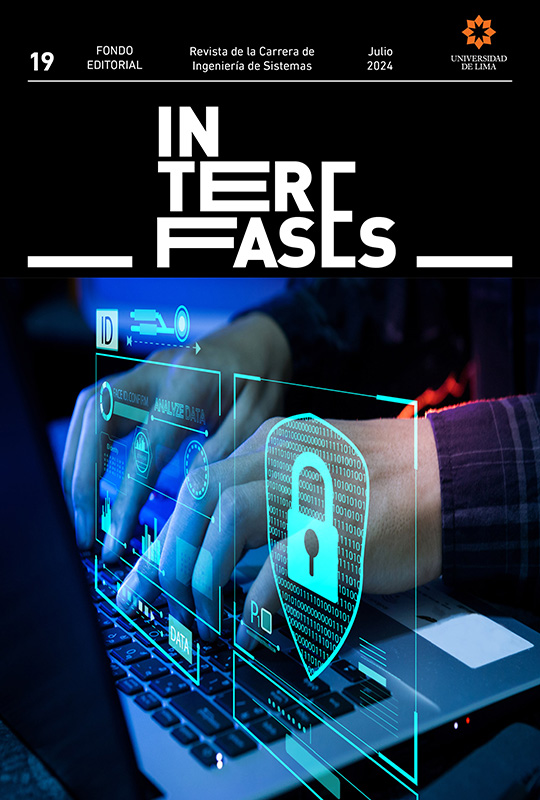Analysis of the Gap Between University and Software Industry in Argentina: A Teaching Perspective and Potential Solutions
DOI:
https://doi.org/10.26439/interfases2024.n19.7061Keywords:
spin-off, UIC, software industry, interstitial spaces, institutional theoryAbstract
This study examines the gap between universities and companies. It specifically aims to identify relevant cognitive variables according to institutional theory (such as motivations, beliefs, concepts, and perceptions) for the agents studied (in this case, university professors) and quantify these variables. The research focuses on the National Technological University and the programs related to the software industry to explore ways to reduce the gap and improve the relationship between the two sectors.
Downloads
References
Alderete, M. V., Porris, M. S., & Verna Etcheber, R. (2020). Hacia un modelo de innovación de cuádruple hélice: experiencias con PyMEs de Bahía Blanca, Argentina. Ciencias Económicas, 1(17), 67-88. https://doi.org/10.14409/rce.v1i0.9994
Arza, V., & Vazquez, C. (2010). Interactions between public research organisations and industry in Argentina. Science and Public Policy, 37(7), 499-511. http://hdl.handle.net/10625/50641
Bahdanava, A., Gaydova, M., Izmailovich, S., Voronko, E., & Kostuchenko, E. (2024). International cooperation between universities and business as a condition for raising human development level. BIO Web of Conferences, 83(06001), 1-14. https://doi.org/10.1051/bioconf/20248306001
Bergenholtz, C., & Bjerregaard, T. (2014). How institutional conditions impact university–industry search strategies and networks. Technology Analysis & Strategic Management, 26(3), 253-266. https://doi.org/10.1080/09537325.2013.850473
Di Meglio, F. (2024). Capacidades y perfiles de vinculación científico-tecnológica en las universidades de la Provincia de Buenos Aires, Argentina. Integración y Conocimiento, 13(1), 234-255. https://doi.org/10.61203/2347-0658.v13.n1.44227
Etzkowitz, H., & Leydesdorff, L. (1997). Universities and the global knowledge economy: a triple helix of university-industry relations. Pinter.
Furnari, S. (2014). Interstitial spaces: micro interaction settings and the genesis of new practices between institutional fields. Academy of Management Review, 39(4), 439-462. https://doi.org/10.5465/amr.2012.0045
Gibson, D. V., & Foss, L. (2017). Developing the entrepreneurial university: architecture and institutional theory. World Technopolis Review, 6(1), 3.1-3.15. https://doi.org/10.7165/WTR17A0809.16
Grosso, M. J. (2019). Especialización productiva y las prácticas de outsourcing y offshoring en el sector de software y servicios informáticos. Pymes, Innovación y Desarrollo, 7(3), 37-62. https://revistas.unc.edu.ar/index.php/pid/article/view/28897
Hernández, M. C., Podestá, M. P., & Bedoya, B. E. (2015). Conditions for the promotion and development of creative industries within higher education institutions [Ponencia]. Proceedings of the 17th International Conference on Engineering and Product Design Education, Loughborough, United Kingdom. https://www.designsociety.org/publication/38436/CONDITIONS+FOR+THE+PROMOTION+AND+DEVELOPMENT+OF+CREATIVE+INDUSTRIES+WITHIN+HIGHER+EDUCATION+INSTITUTIONS
Jiménez, C. N., & Castellanos, O. F. (2008). Desafíos en gestión tecnológica para las universidades como generadoras de conocimiento [Presentación de paper].
I Congreso Internacional de Gestión Tecnológica e Innovación, Bogotá, Colombia.
Krepki, D. (2024). El garaje en la empresa: jóvenes trabajadorxs intra-emprendedores en la industria tecnológica argentina. El caso Globant. Trabajo y Sociedad, 25(42), 5-18. http://www.scielo.org.ar/pdf/tys/v25n42/1514-6871-tys-25-42-5.pdf
Lauric, A., Scoponi, L., Torres Carbonell, C., & De Leo, G. (2024). Vinculación DCAUNS- AERINTA Bahía Blanca-sector productivo: indicadores para la gestión de la sustentabilidad de Pymes agropecuarias en ambientes frágiles de Argentina. En C. Garrido-Noguera y D. García Pérez de Lema (Coords.), Universidades, Economía Circular y los ODS en el espacio birregional ALCUE (pp. 131-148). ALCUE, FAEDPYME, Unión de universidades de América Latina y El Caribe. https://dialnet.unirioja.es/servlet/libro?codigo=976325
Massaro, F. (2016). Un nuevo modelo teórico sobre los procesos de Spinout. Aplicación y validación estadística para el sistema científico-tecnológico argentino (período 2005-2015) [Tesis de doctorado, Universidad Nacional de Lomas de Zamora]. Repositorio Institucional Digital de Acceso Abierto de la UNLZ.
Ortiz, F. D. (2019). Establecimiento del estado del arte de la gestión de riesgos en el proceso de implantación de sistemas informáticos [Tesis de maestría, Universidad Tecnológica Nacional Facultad Regional Buenos Aires].
Peksatici, Ö., & Ergun, H. S. (2019). The gap between academy and industry. A qualitative study in Turkish aviation context. Journal of Air Transport Management, 79, 101687. https://doi.org/10.1016/j.jairtraman.2019.101687
Sales, M. (2021). Diagrama de pareto. EALDE Business School. https://www.gestiopolis.com/diagrama-de-pareto/
Scott, W. R. (1987). The adolescence of institutional theory. Administrative science quarterly.
Universidad Tecnológica Nacional. (2022, 15 de junio). Ordenanza 1877/22 sobre diseño curricular de la carrera en Ingeniería en Sistemas de Información. Plan 2023. https://www.frba.utn.edu.ar/wp-content/uploads/2022/12/Ordenanza-1877-Plan-ISI2023.pdf
Taucean, I. M., Strauti, A. G., & Tion, M. (2018). Roadmap to entrepreneurial university–Case study. Procedia-Social and Behavioral Sciences, 238, 582-589. https://doi.org/10.1016/j.sbspro.2018.04.038
Zachman, P. P., & Redchuk, A. (2016). Singularities of the university spin-off in northern Argentina. En A. Rocha, A. Correia, H. Adeli, L. P. Reis & M. Mendonça (Eds.), New advances in information systems and technologies. Springer.
Downloads
Published
Issue
Section
License
Authors who publish with this journal agree to the following terms:
Authors retain copyright and grant the journal right of first publication with the work simultaneously licensed under an Attribution 4.0 International (CC BY 4.0) License. that allows others to share the work with an acknowledgement of the work's authorship and initial publication in this journal.
Authors are able to enter into separate, additional contractual arrangements for the non-exclusive distribution of the journal's published version of the work (e.g., post it to an institutional repository or publish it in a book), with an acknowledgement of its initial publication in this journal.
Authors are permitted and encouraged to post their work online (e.g., in institutional repositories or on their website) prior to and during the submission process, as it can lead to productive exchanges, as well as earlier and greater citation of published work (See The Effect of Open Access).
Last updated 03/05/21


